Viruses
1/72
Earn XP
Description and Tags
All business nothing personal
Name | Mastery | Learn | Test | Matching | Spaced |
|---|
No study sessions yet.
73 Terms
Virus
Microscopic, non-cellular particle made of genetic material (DNA or RNA) and protein that can invade a living cell.
Viruses are …
Obligate intracellular parasites = can only reproduce by invading a host cell and using enzymes and organelles of the host cell to make more viruses.
Size range of viruses
10 nm to 400 nm. Can only be seen with an electron microscope. Compared to bacteria viruses are many times smaller.
Typical virus two parts
Nucleic acid core (DNA or RNA)
Protective outer protein coat or capsid
Draw and label of “typical” virus structure
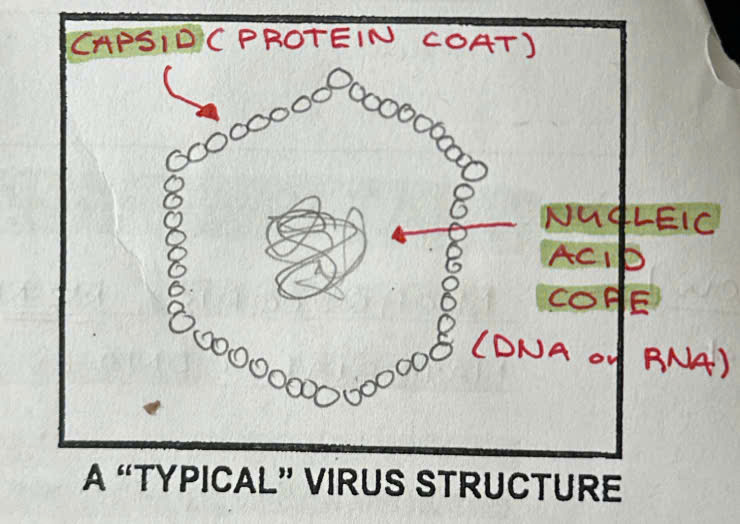
Nucleic acid core
Either DNA or RNA (never both)
Nucleic acid strand may be single or double, linear or circular.
Enables the virus to reproduce new viruses exactly like itself.
Protective outer protein coat (capsid)
Approx. 95% body of virus
Capsids built from a large number of protein subunits capsomeres.
Some proteins make up body of virus are enzymes
Protects the nucleic acid core
4 main virus shapes
helical, polyhedral, enveloped, complex
Helical
Rod-shaped viruses made of repeating units of protein in a spiral/helical arrangement, surrounds a helical strand of nucleic acid runs the length of the virus
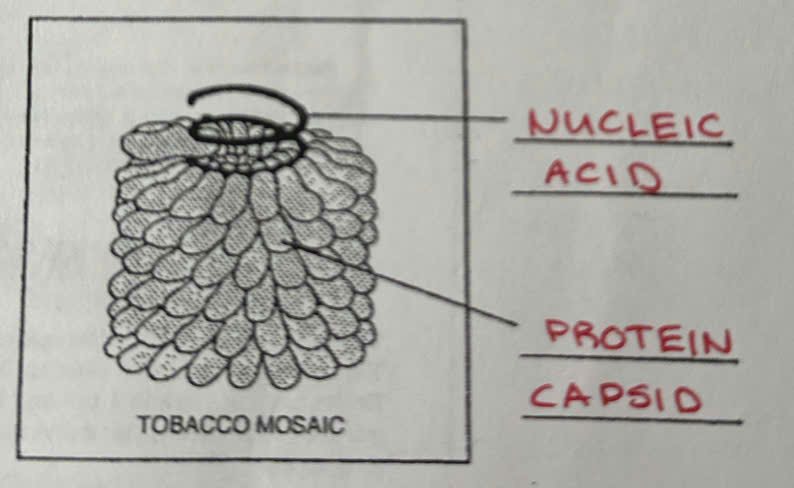
Example of helical viruses
Tobacco Mosaic Virus, Rabies
Polyhedral
Capsid proteins form a polyhedron with 20 triangular faces and 12 corners.
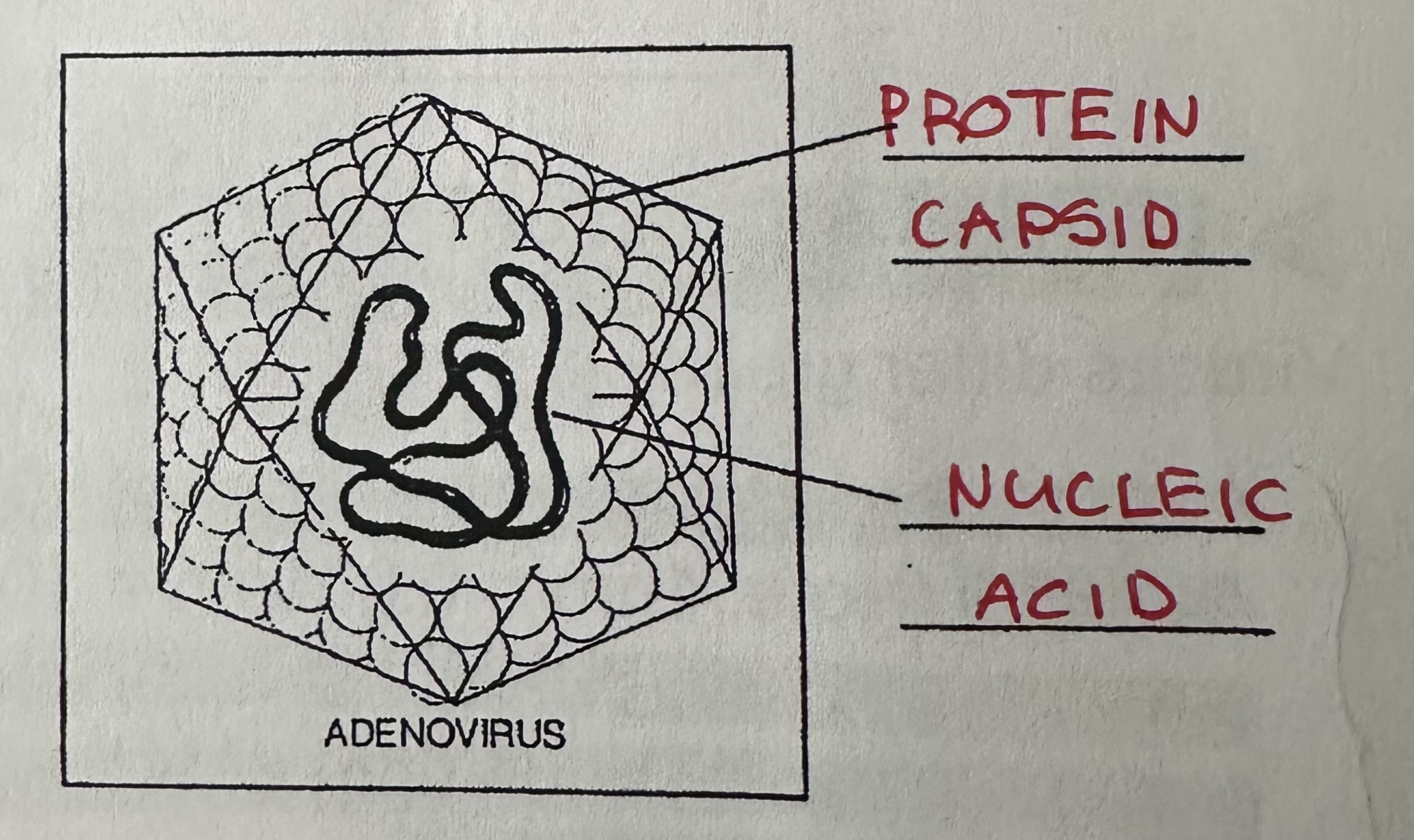
Example of polyhedral viruses
Adenovirus, Poliovirus
Enveloped
Have a capsid that is covered by an envelope consisting of protein, lipids and carbohydrates. Has
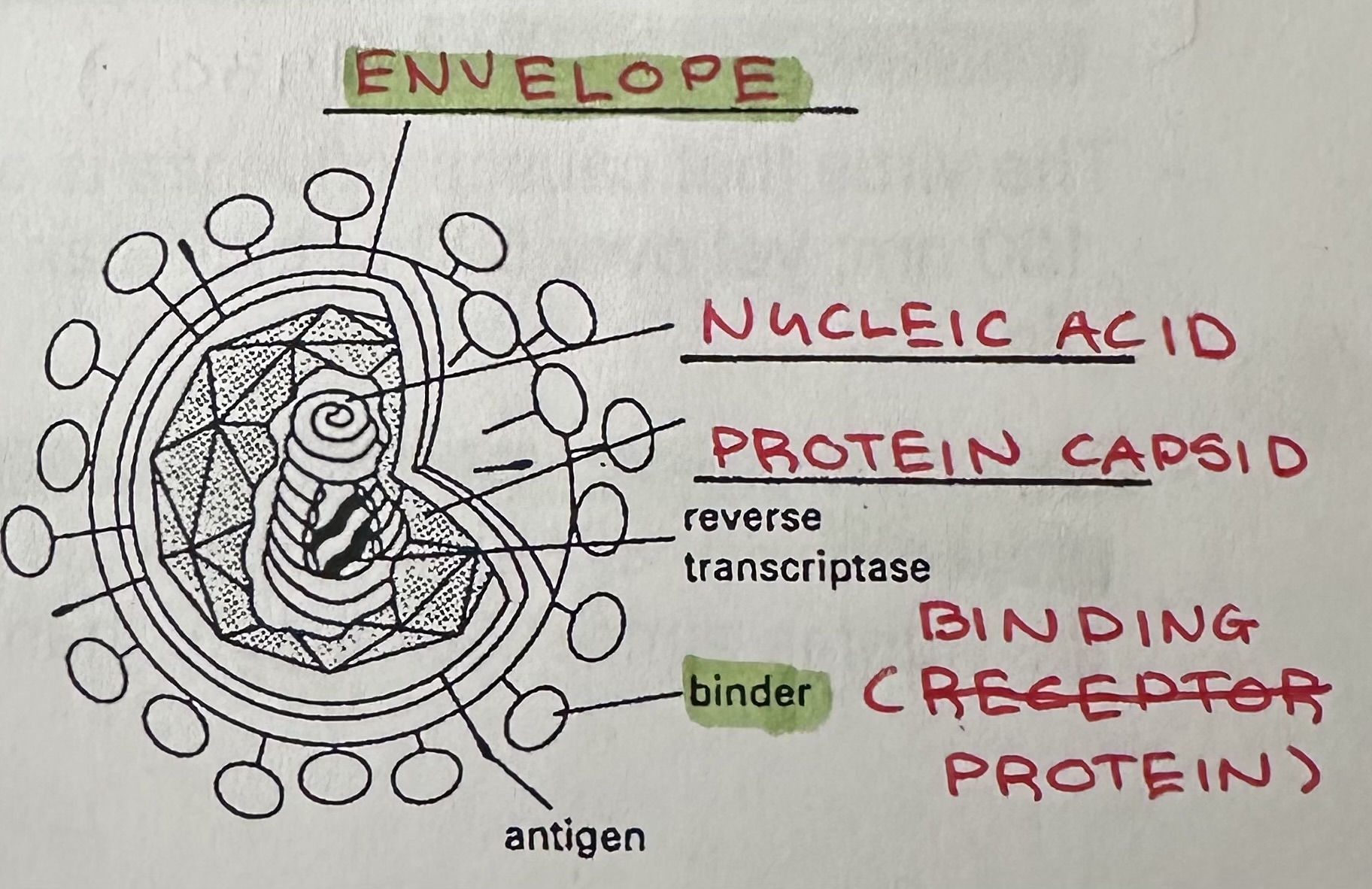
Example of enveloped viruses
Influenza virus, HIV
Complex and example
Made up of a combination of other forms
e.g. Bacteriophage (only invade bacteria) have a polyhedral head (surrounds nucleic acid strand) and a hollow helical tail.
Tail fibers: structures by which the virus attaches itself to a bacterium.
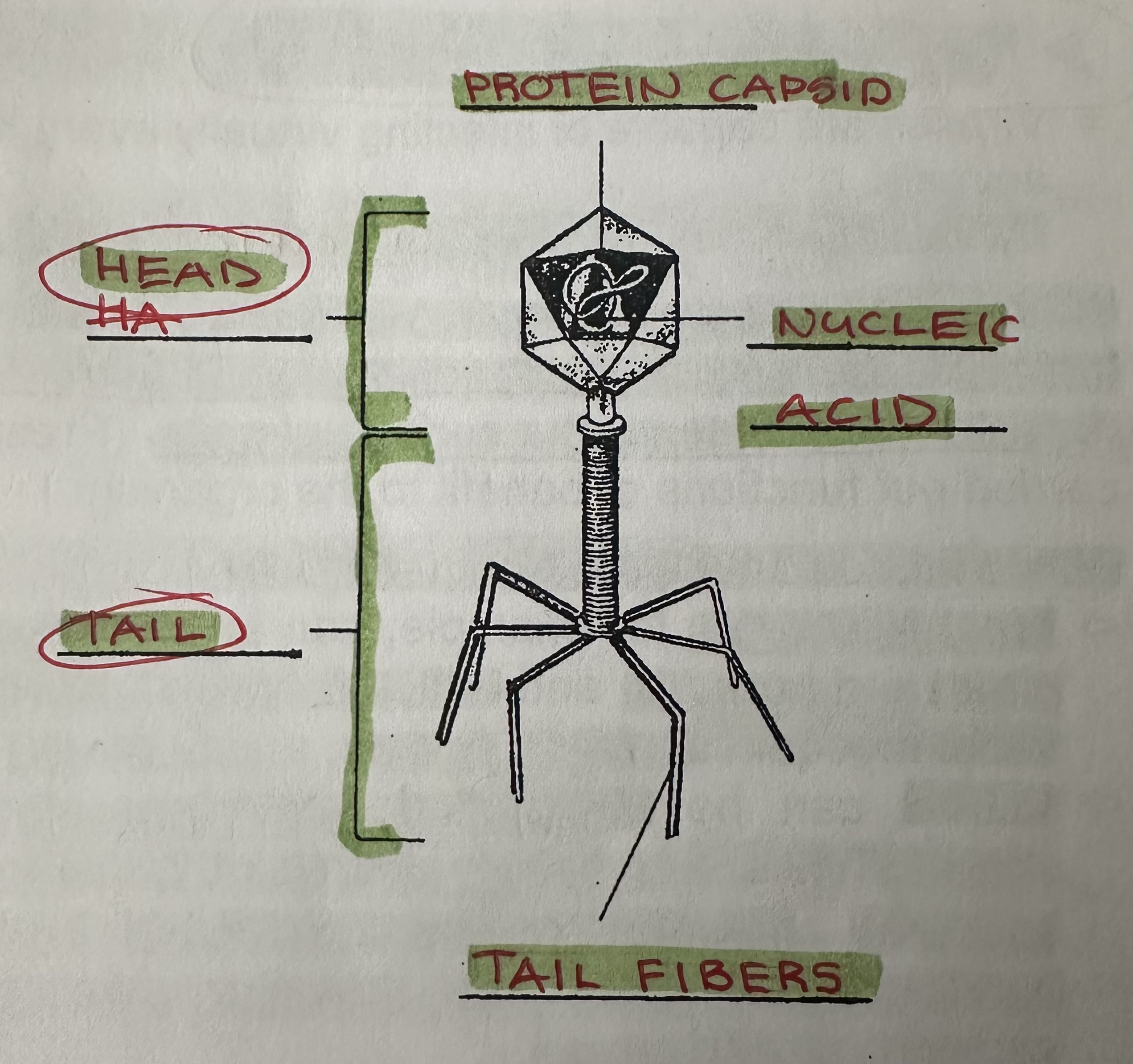
Viral specificity
Viruses are very specific in host cells (host range)
Results from evolution of virus recognition system, by a “lock-and-key” fit between the proteins on the virus surface and specific receptor molecules on the cell’s surface.
Some virus have broad host ranges …
West Nile virus infect mosquitoes, birds, and humans.
Equine encephalitis virus can infect mosquitoes, birds, horses, and humans.
Other viruses have host ranges …
So narrow thay they infect only a single species, or single tissues within that species.
Tobacco Mosaic virus only attacks specific tobacco plants and attacks only the leaf tissues.
Infection by viruses of multicellular …
Eukaryotes is usually limited to particular tissues. Human cold viruses infect only the cells lining the upper respiratory tract, rabies virus and poliovirus infect only nerve cells, HIV binds to specific receptors on certain white blood cells (helper-t cells).
Characteristics that support the scientist who argue that viruses are alive
Contain genetic material (DNA or RNA), protein coat, small amount of enzyme.
Display diversity and evolve and ± reproduce
Characteristics that support the scientist who argue that viruses are not alive
Non-cellular, can’t live independently
Do not undergo aerobic cellular respiration (ATP production)
Do not respond to stimuli
Do not grow (unless infect living cell)
Reproduce only within living cells (Do not directly come from pre-existing viruses)
Can solidified into crystals (placed in solution active again)
“Life” cycle (reproductive cycle) of viruses
Must invade or infect a living host cell to reproduce.
Isolated viruses are merely packaged sets of genes in transit from one host cell to another.
General features of viral reproductive cycles
1)
A viral infection begins when the genome (DNA or RNA) of a virus makes it way into a host cell.
2 & 3)
Once DNA ( or RNA ) is inside, can “hijack” the host cell to copy the viral nucleic acid and manufacture viral proteins.
4)
Viral nucleic acid and proteins (capsomeres) are assembled into new viruses.
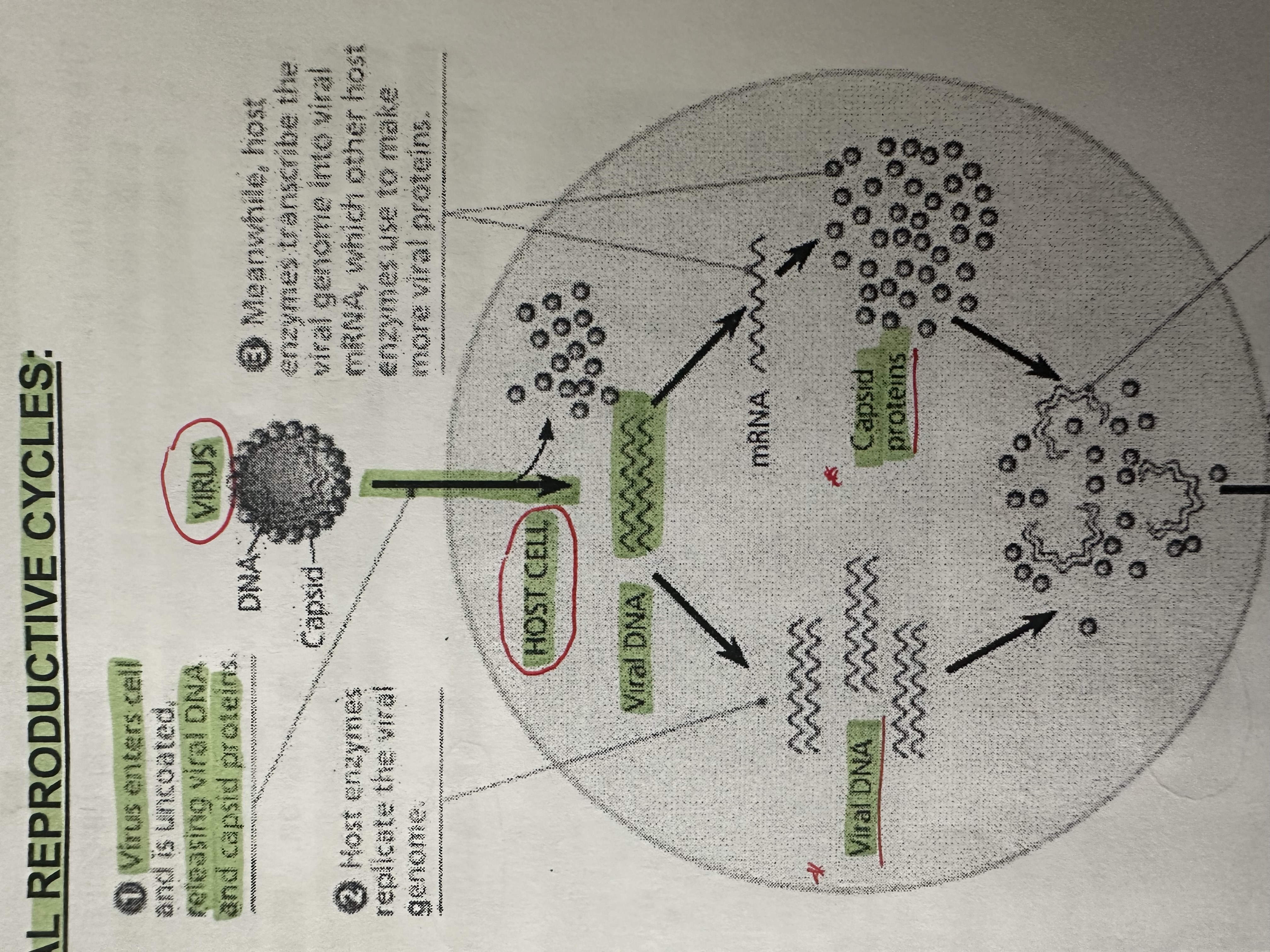
The simplest type of viral reproductive cycle ends with …
the exit of hundreds or thousands of virses from the infected host cell, often damages or destroys the cell. The viral progeny (virus offsprings) have the potential to infect additional cells, spreading the viral infection.
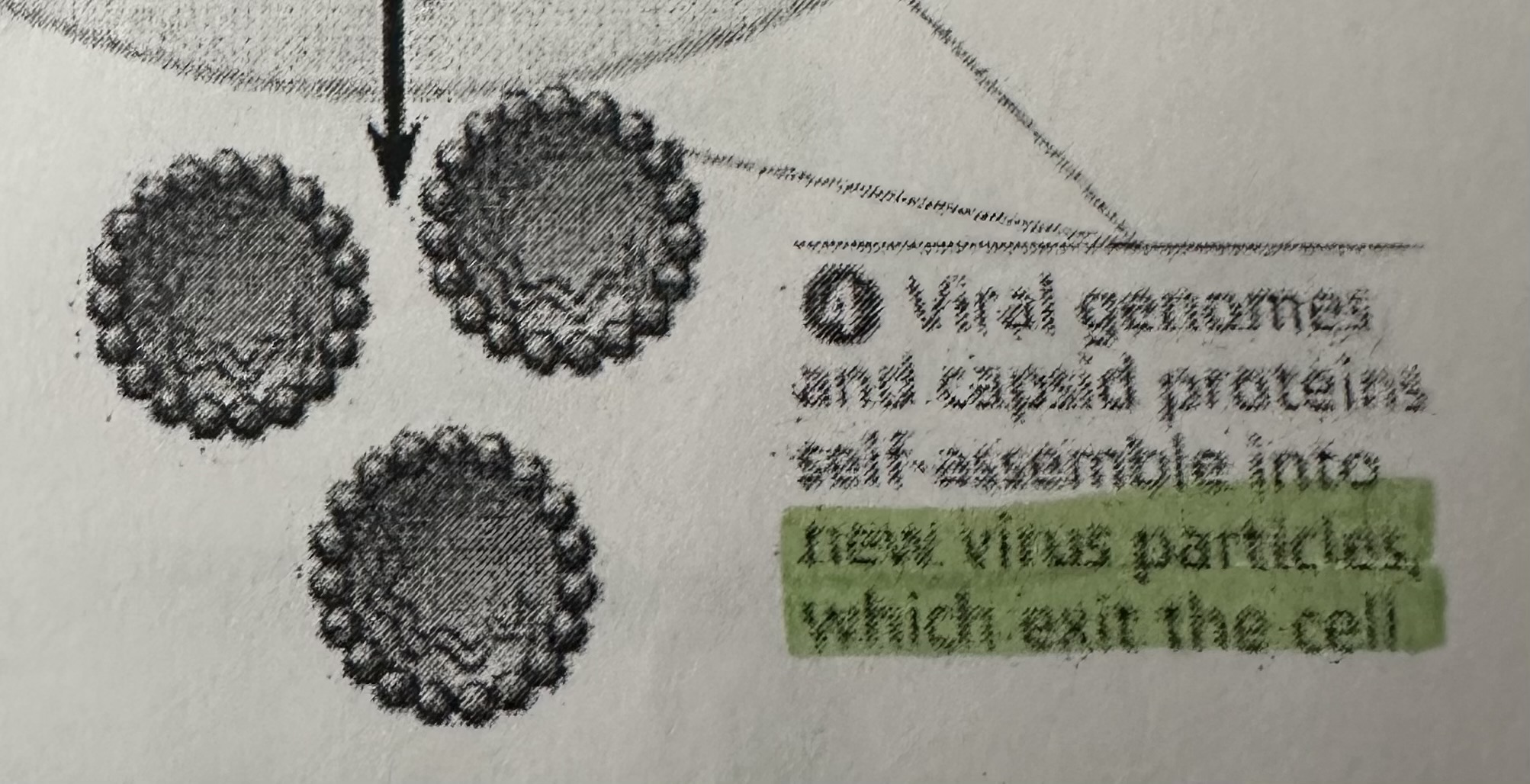
Viruses can reproduce by …
two alternative mechanisms: the lytic cycle and the lysogenic cycle
Lytic cycle (Lytic infection)
Process in which a host cell is invaded, lysed (burst), and destroyed by the virus.
“Lytic” refers to the breaking apart of cells.
Lytic cycle (bacteriophage)
Steps in a phage attack on a host bacterial cell.
Viruses invade, reproduce, and exit immediately.
A bacteriophage that reproduces only by lytic cycle is a virulent phage
Lysis used as a tool to detect viruses
If a culture of bacteria is inoculated with bacteriophages, the lysis of bacterial cells make the culture appear clear (plaques).
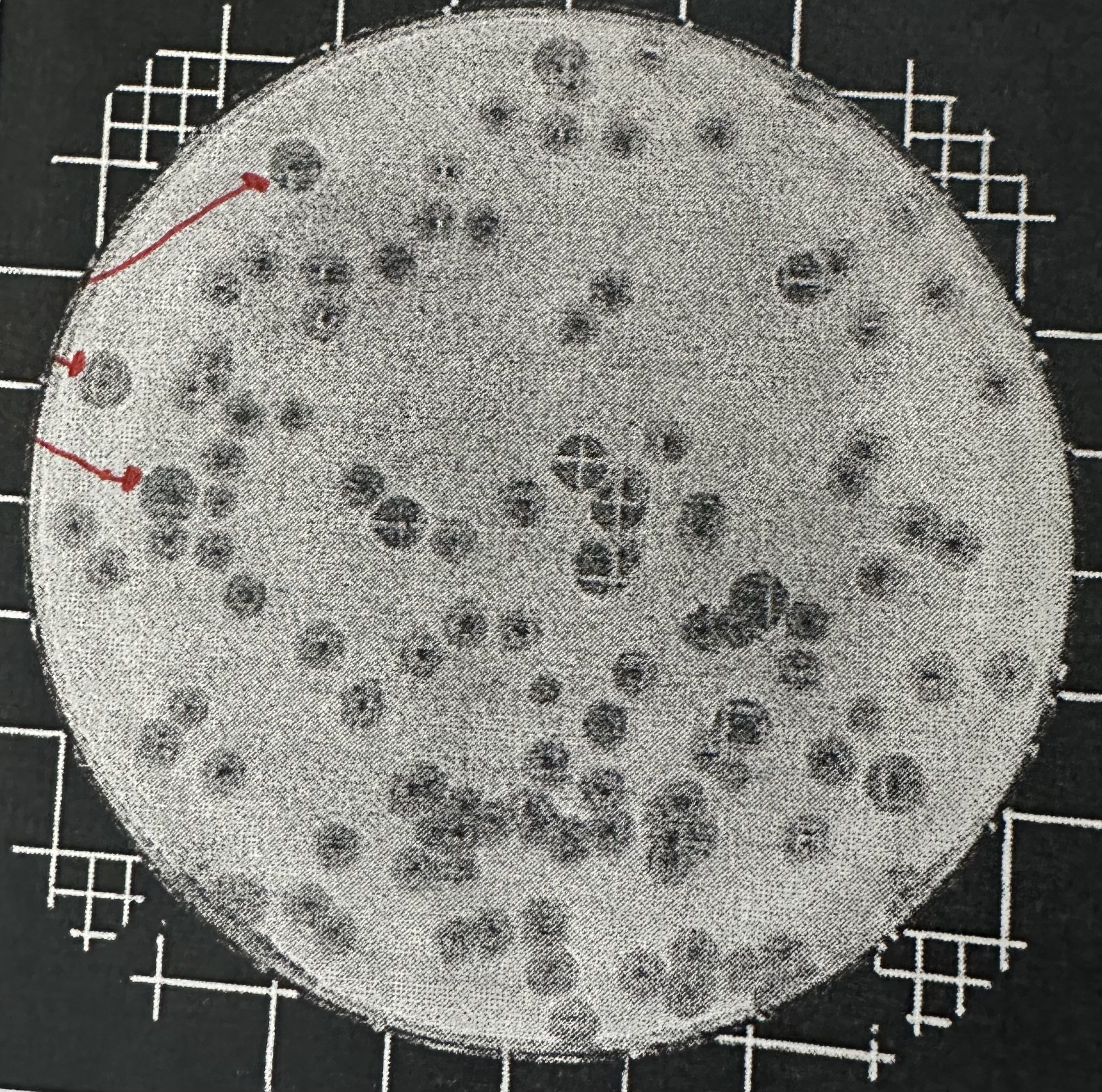
Plaques
Spots of dead bacteria
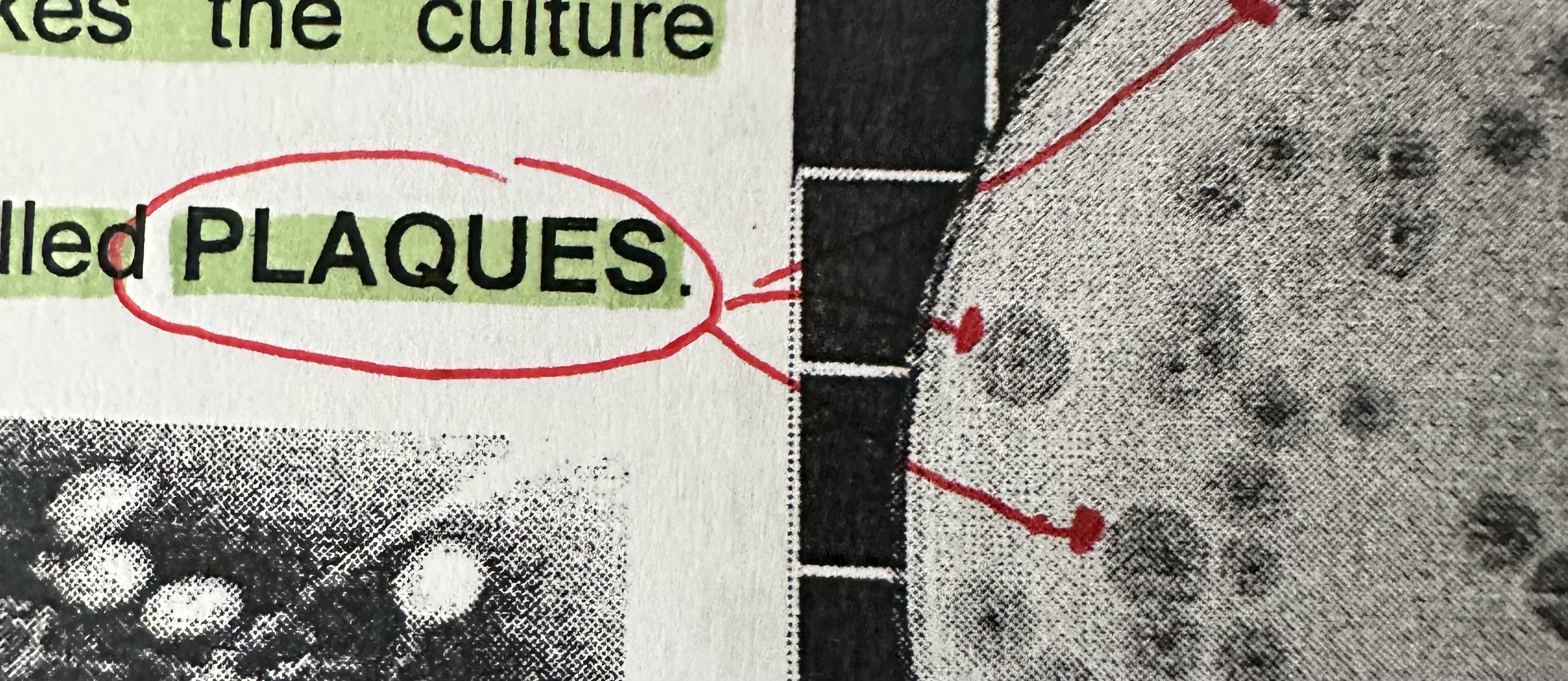
Lytic cycle 5 main stages
Adsorption
Entry
Replication
Assembly
Lysis & Release

Adsorption
Attachment of the virus to the host cell
Bacteriophage attaches itself tail down to a specific host bacterial cell, because tail fibers of the phage are chemically attracted to specific receptor sites on the bacterial cell wall (lock and key).
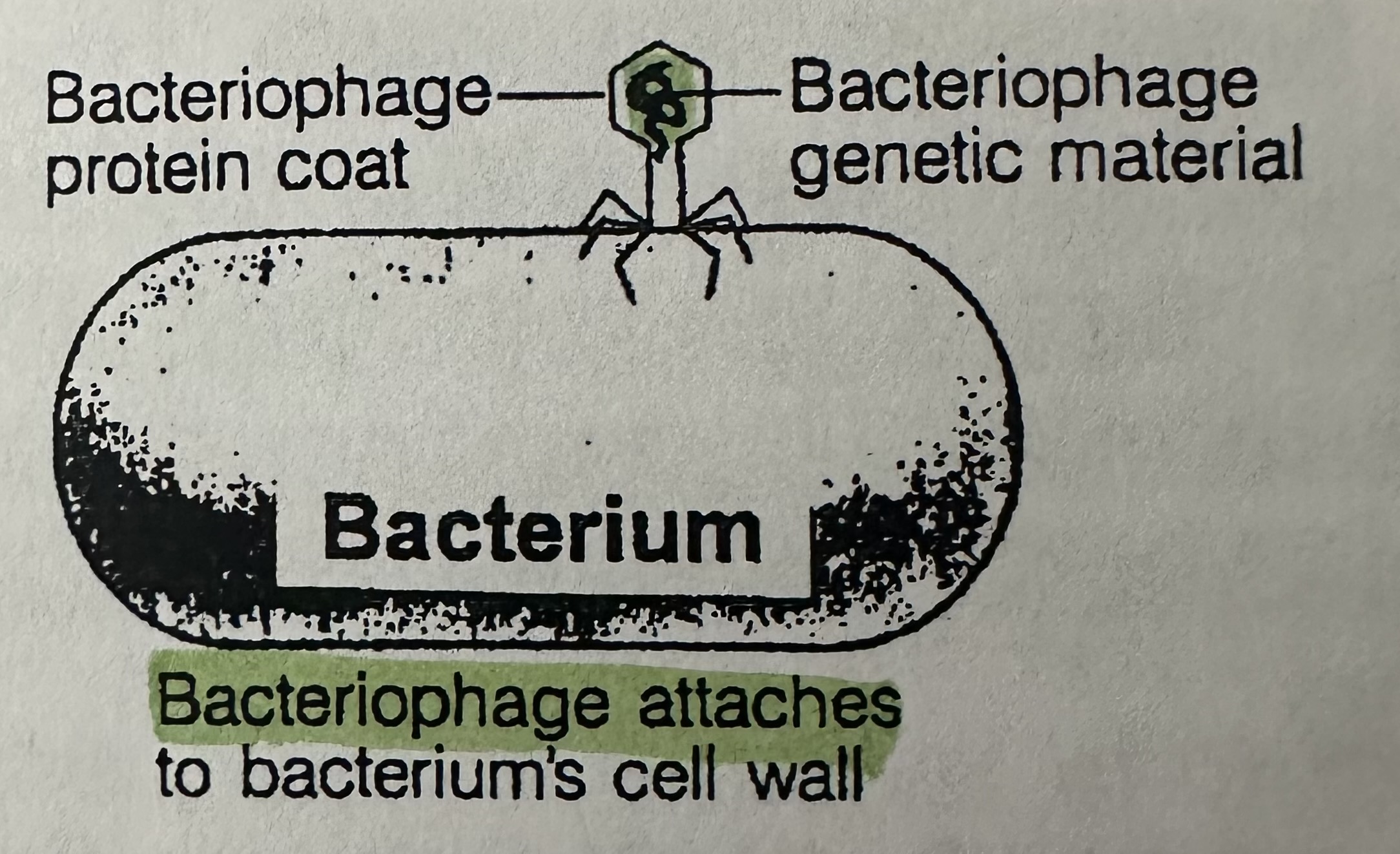
Entry
Injection of the viral genetic material into the host cell.
Bacteriophage releases an enzyme that breaks down the bacterial cell wall. Injects DNA through hollow tail into host bacterium.
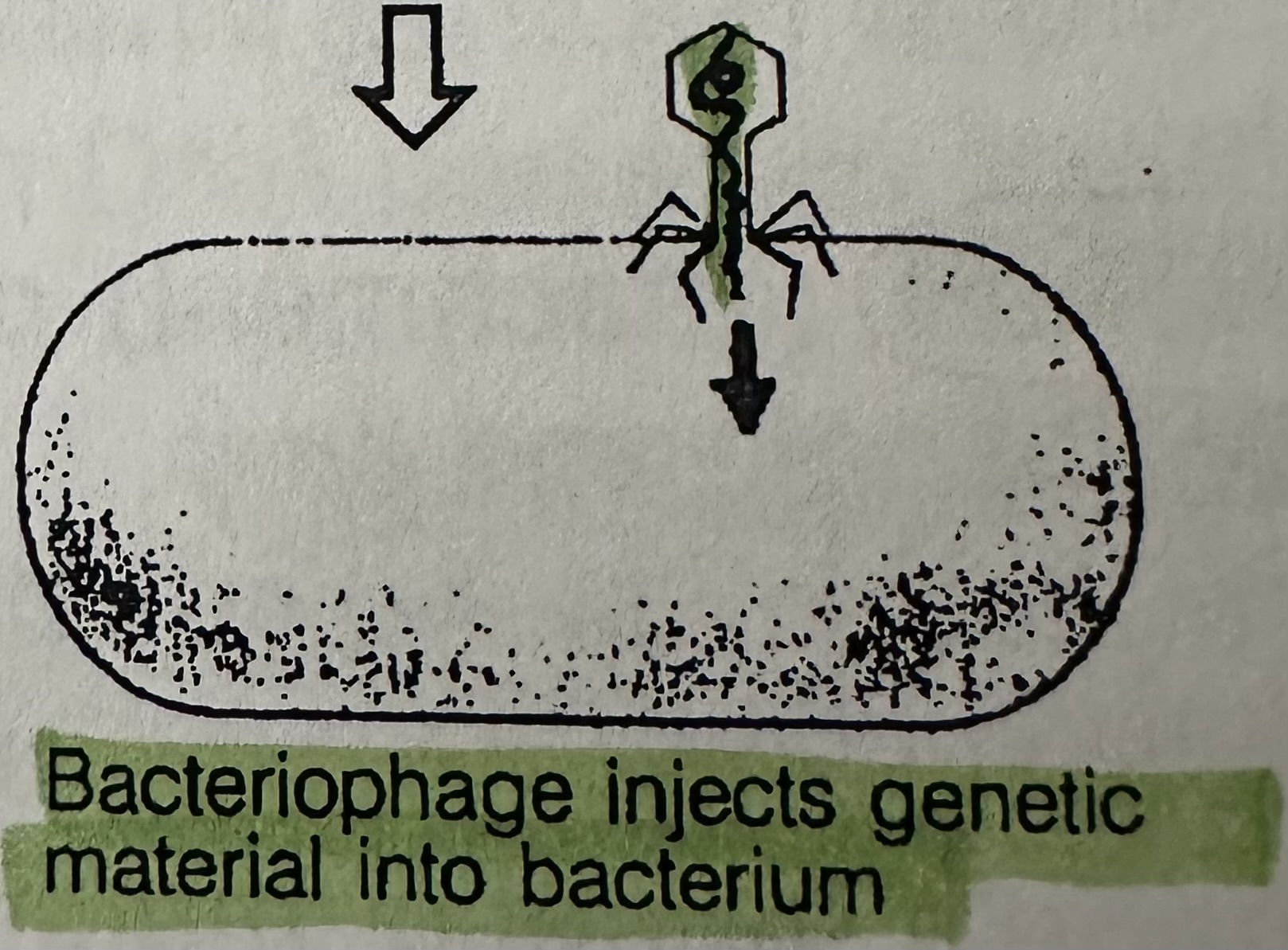
Replication
Alteration of the host cell’s genetic material, causing synthesis of new viral nucleic acids and proteins.
Bacteriophage’s DNA takes over control of the host bacterial cell’s activity. replication of new viral DNA and synthesis of viral proteins.
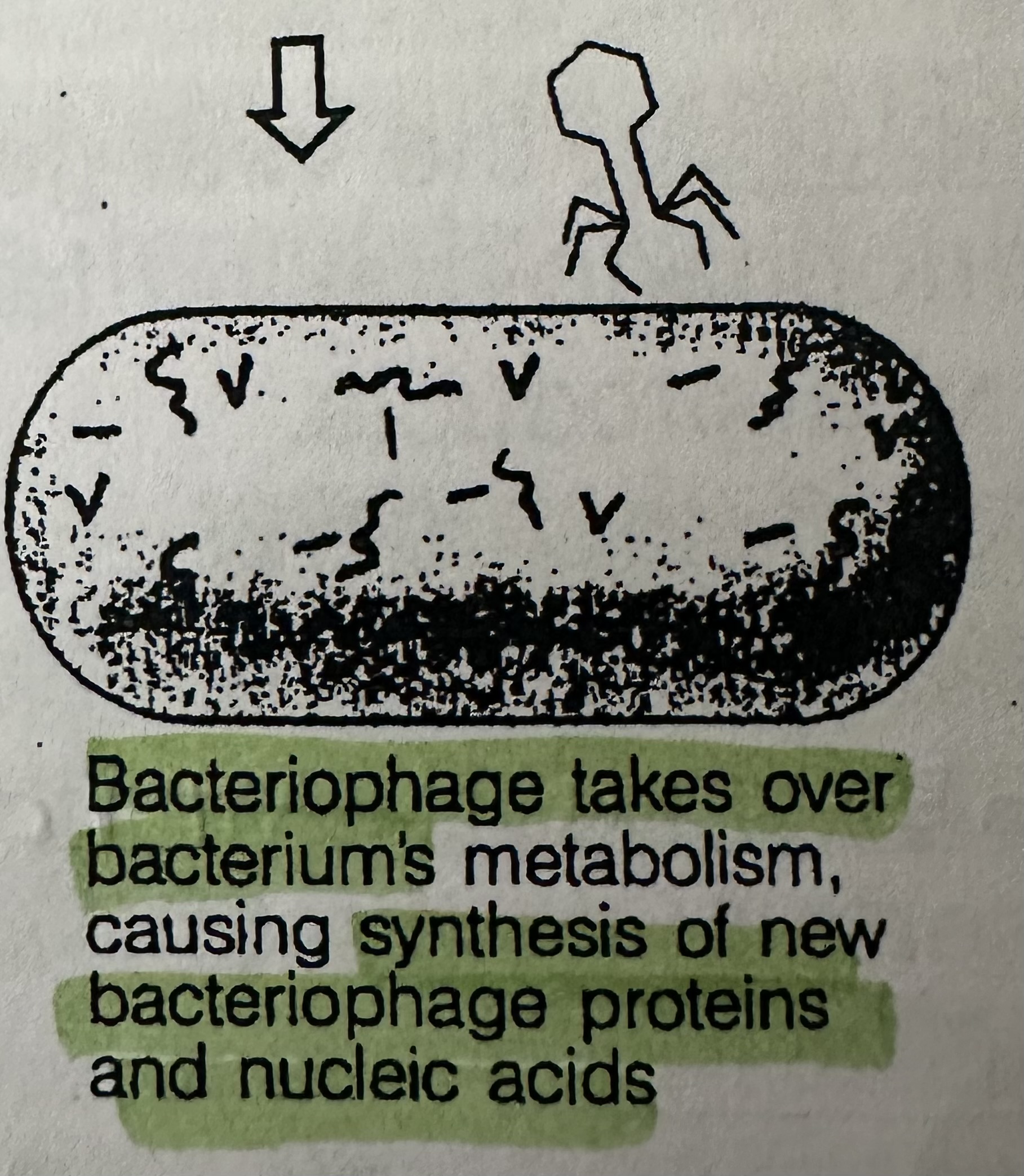
Assembly
Assembly of the viral nucleic acids and proteins into new, complete viruses.
Proteins (enzymes) coded for by the phage DNA put new viruses together. Results in a bacterial cell stuffed with many copies of new viruses.
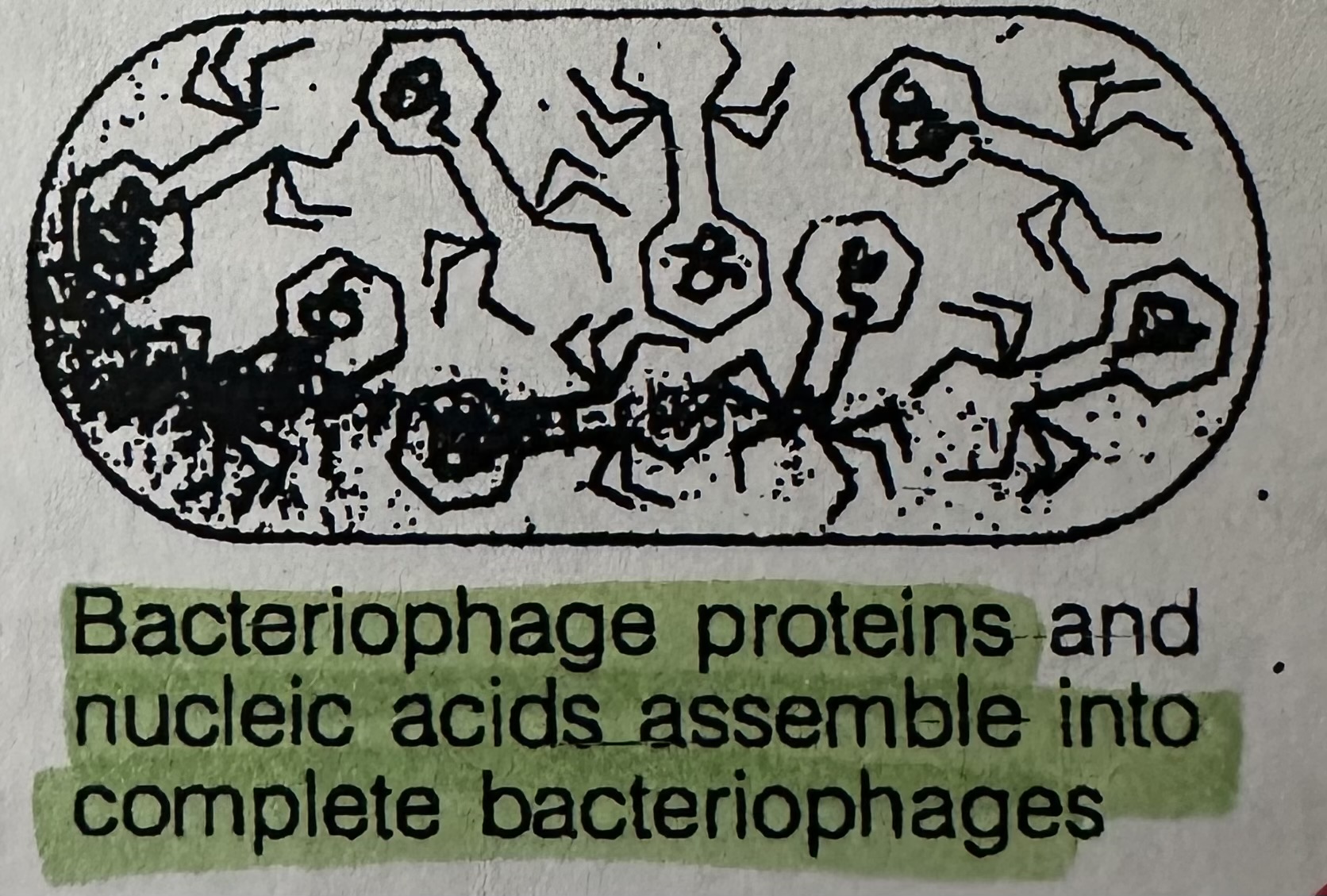
Replication and Assembly …
Virus uses the host cell’s enzymes, nucleotides, ribosomes, etc
Lysis & Release
release of new viruses
Newly assembled bacteriophages release an enzyme that digests the bacterial cell wall from within (Lysis). The cell bursts (cell death too), releasing hundreds of new viruses.
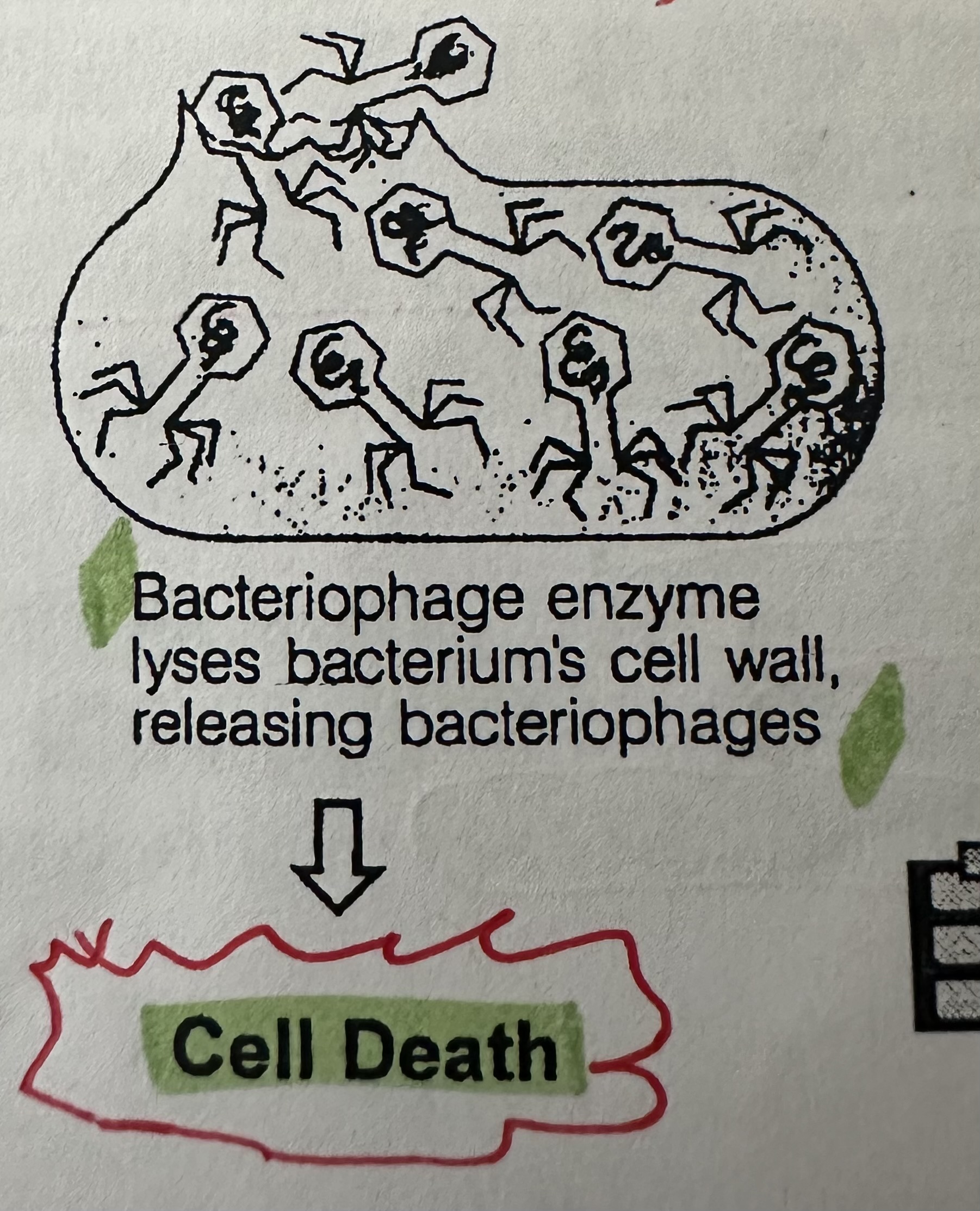
The new viruses can …
infect other cells, and the lytic cycle can start again.
Reasons why bacteriophage haven’t completely wiped out bacteria
Natural selection favors bacterial mutants with receptor sites no longer recognized by a specific phage.
When phage DNA enters a bacterium, DNA is often recognized and cut up by cellular enzymes (restriction enzymes).
Instead of lysing and killing host cells, many phaged coexist within them (lysogenic cycle)
Lysogenic infection
Virus does not immediately reproduce and lyse (kill) the host cell. Viral genetic material is inserted into the DNA of the host cell, where it can remain for many generations (of cells) before becoming active.
Lysogenic cycle
“Latent infection”
The inactive cycle
Takes a long time for cellular damage to occur compared to virulent viruses (lytic)
The lysogenic cycle is similar to …
the initial steps in the lytic cycle. There is:
Adsorption - bacteriophage attaches to a specific host cell.
Entry - genetic material enters the bacterium.
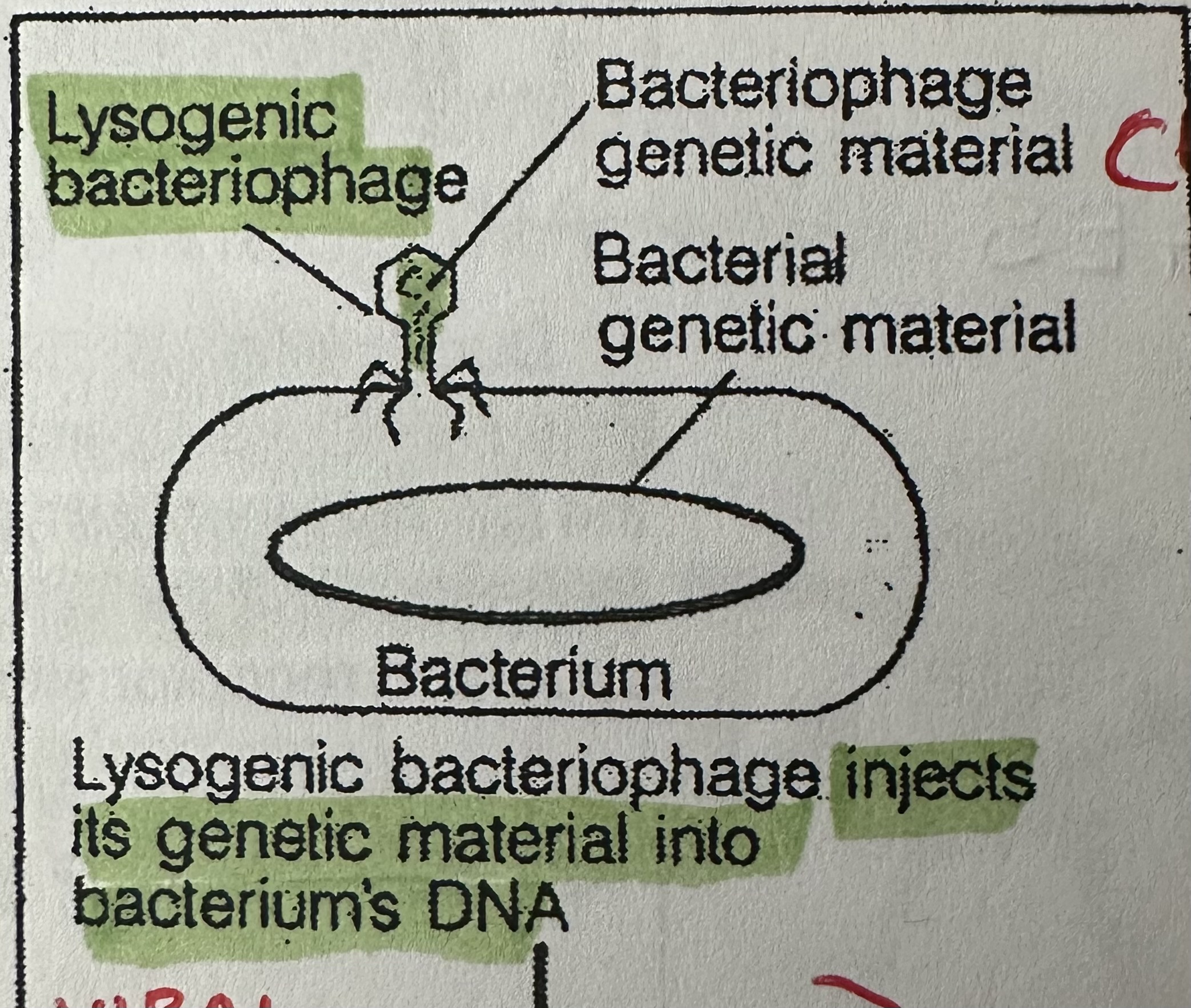
Then during the lysogenic cycle
Viral DNA molecule combines with the DNA of the host bacterial cell (recombination)
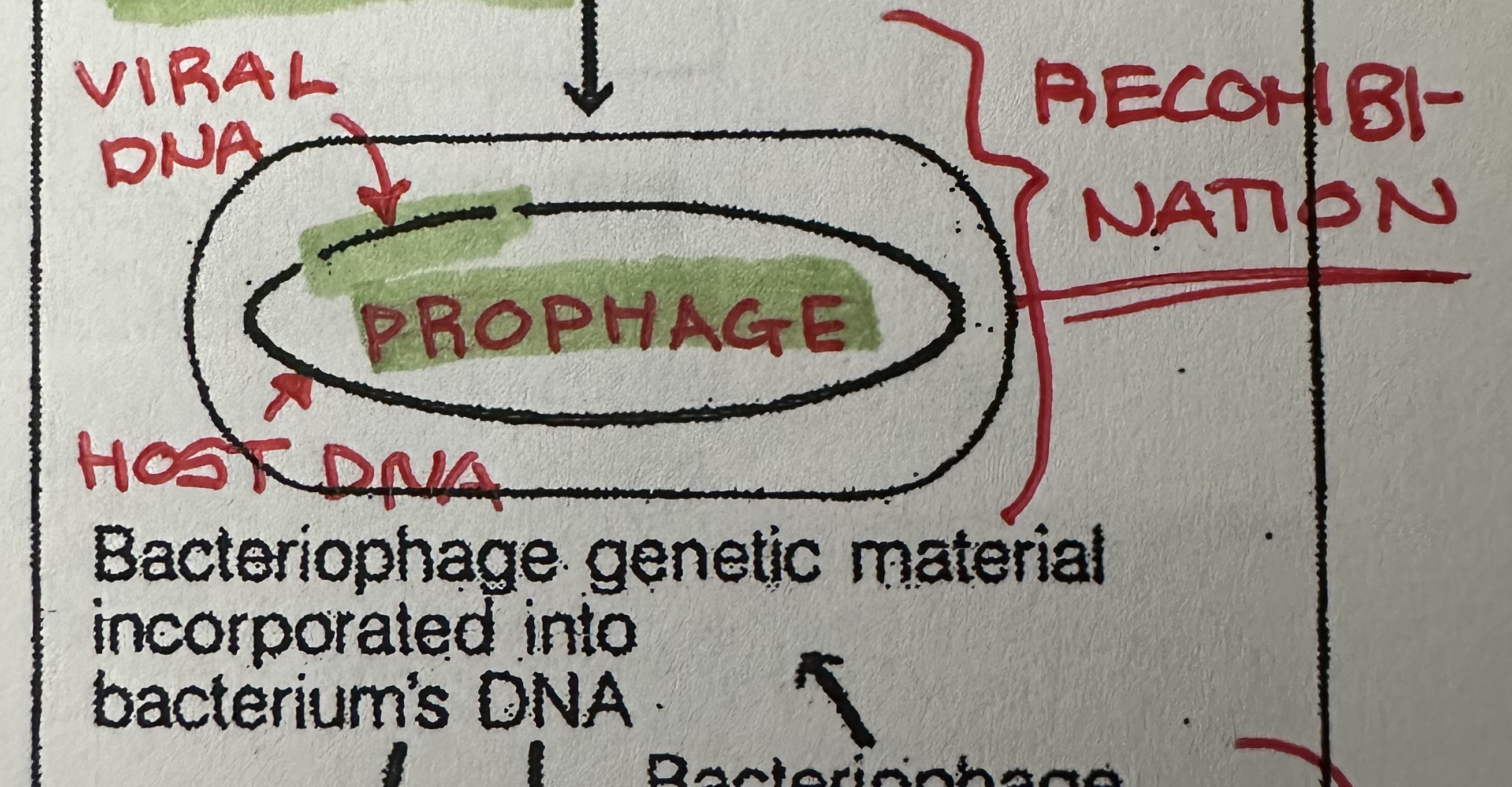
Prophage
Host cell’s DNA and the viral DNA.
Only in bacteria.
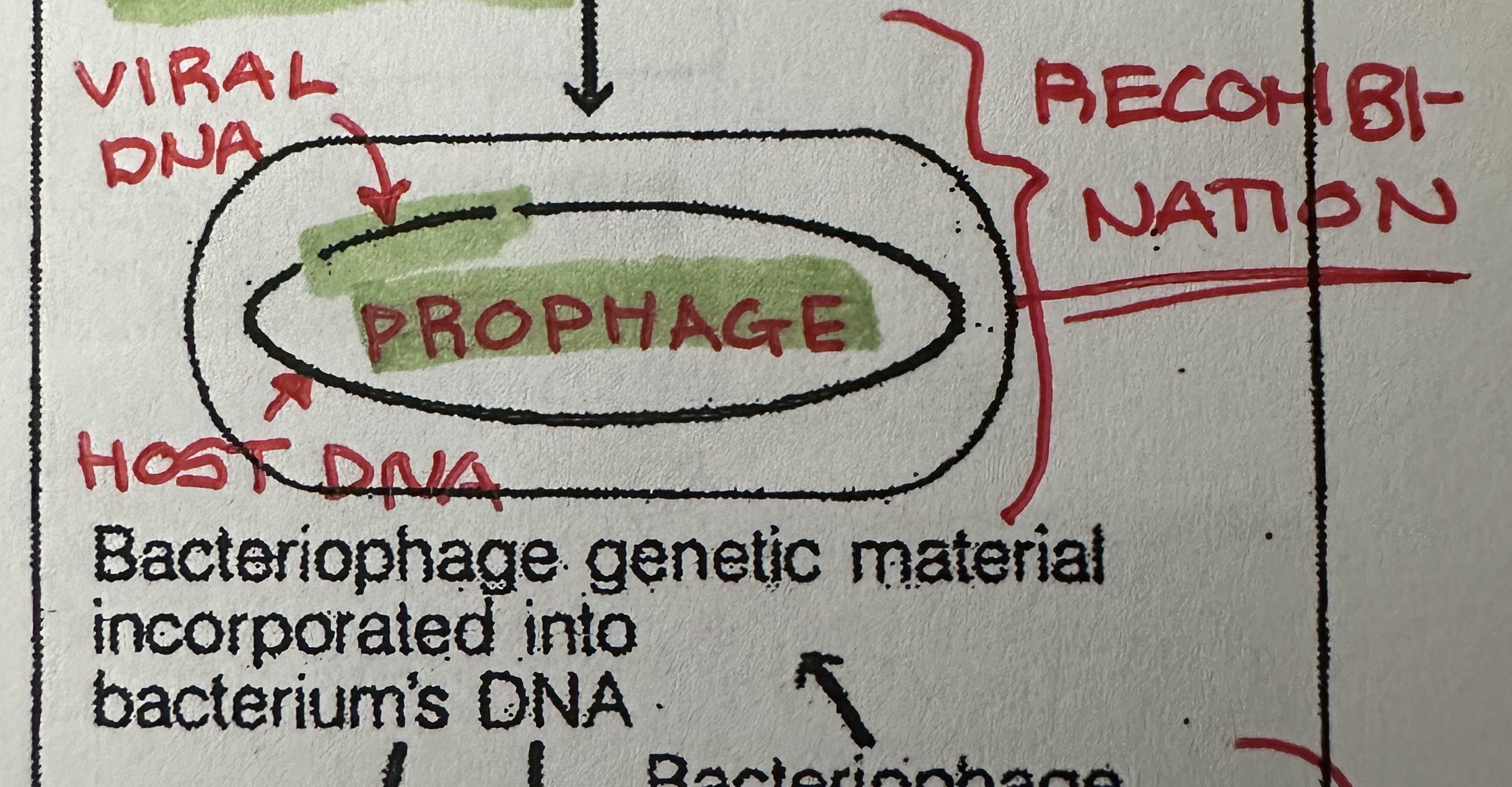
Provirus
Not a prophage, has the same defintion.
Latent period
Prophage remaining inactive in the host cell for a long time
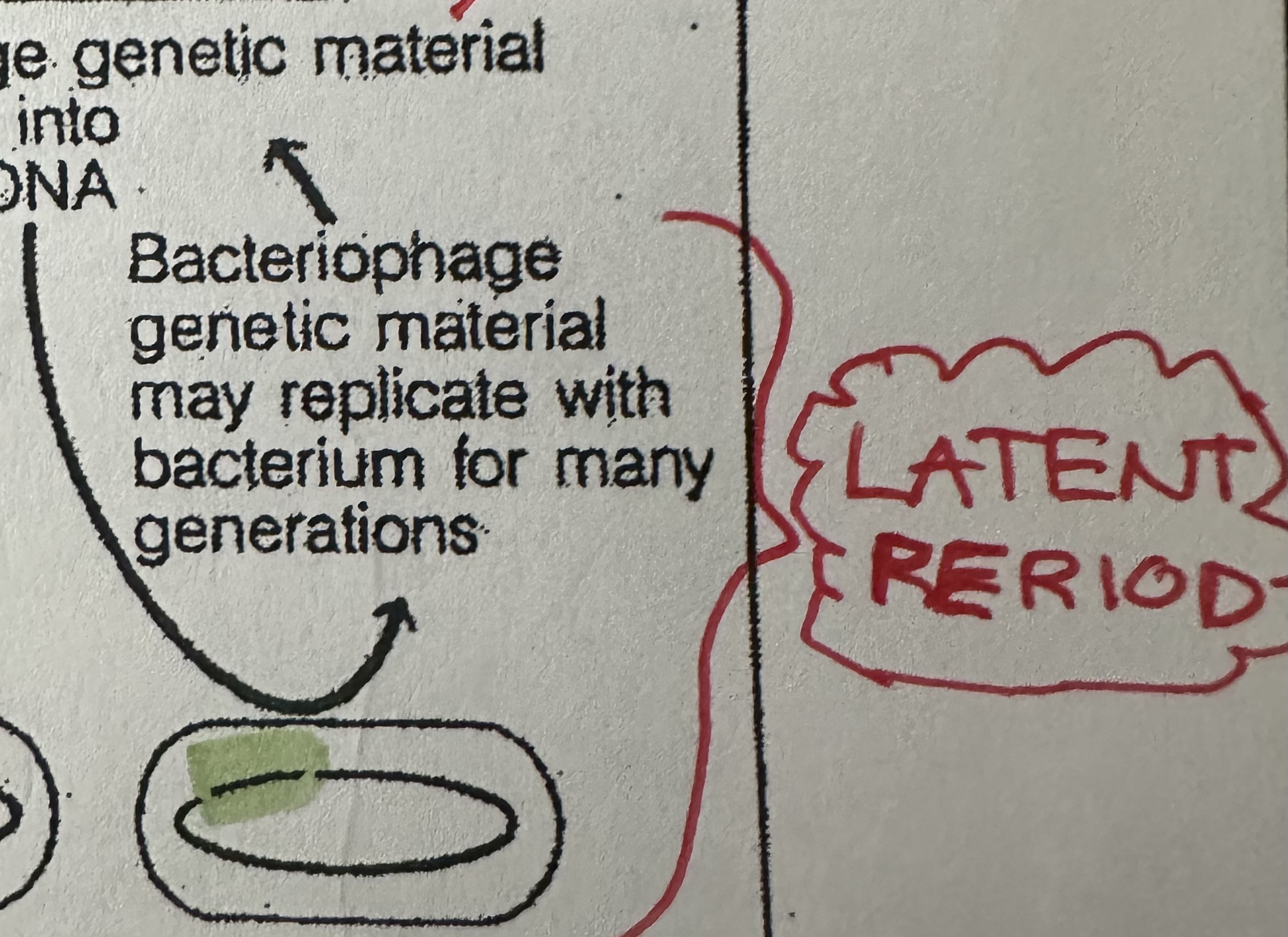
A virus may …
not stay in the prophage form indefinitely.
Certain factors,
such as sudden changes in temperature, availability of nutrients, and exposure to radiation & certain chemicals can activate the DNA of the prophage, removing itself from the DNA host bacterial cell.
Continues on a similiar to the lytic cycle with:
Replication of phage proteins and nucleic acids
Assembly into new viruses
Lysis & Release of new viruses, results in destruction of host bacterial cell.
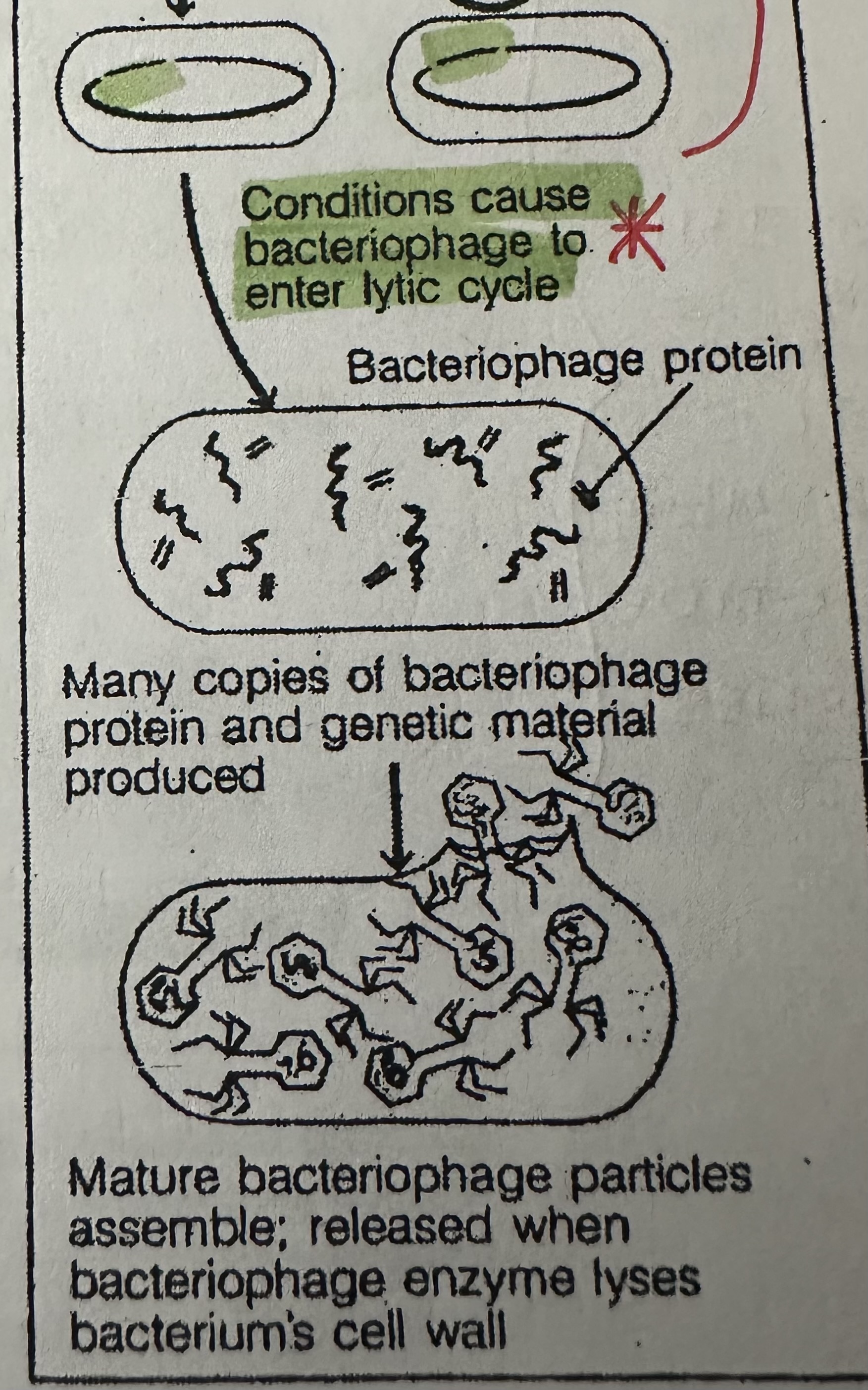
Herpes viruses
remain latent until some sort of physical or emotional stress triggers a new round of active active. Infection of other cells causes cold sores.
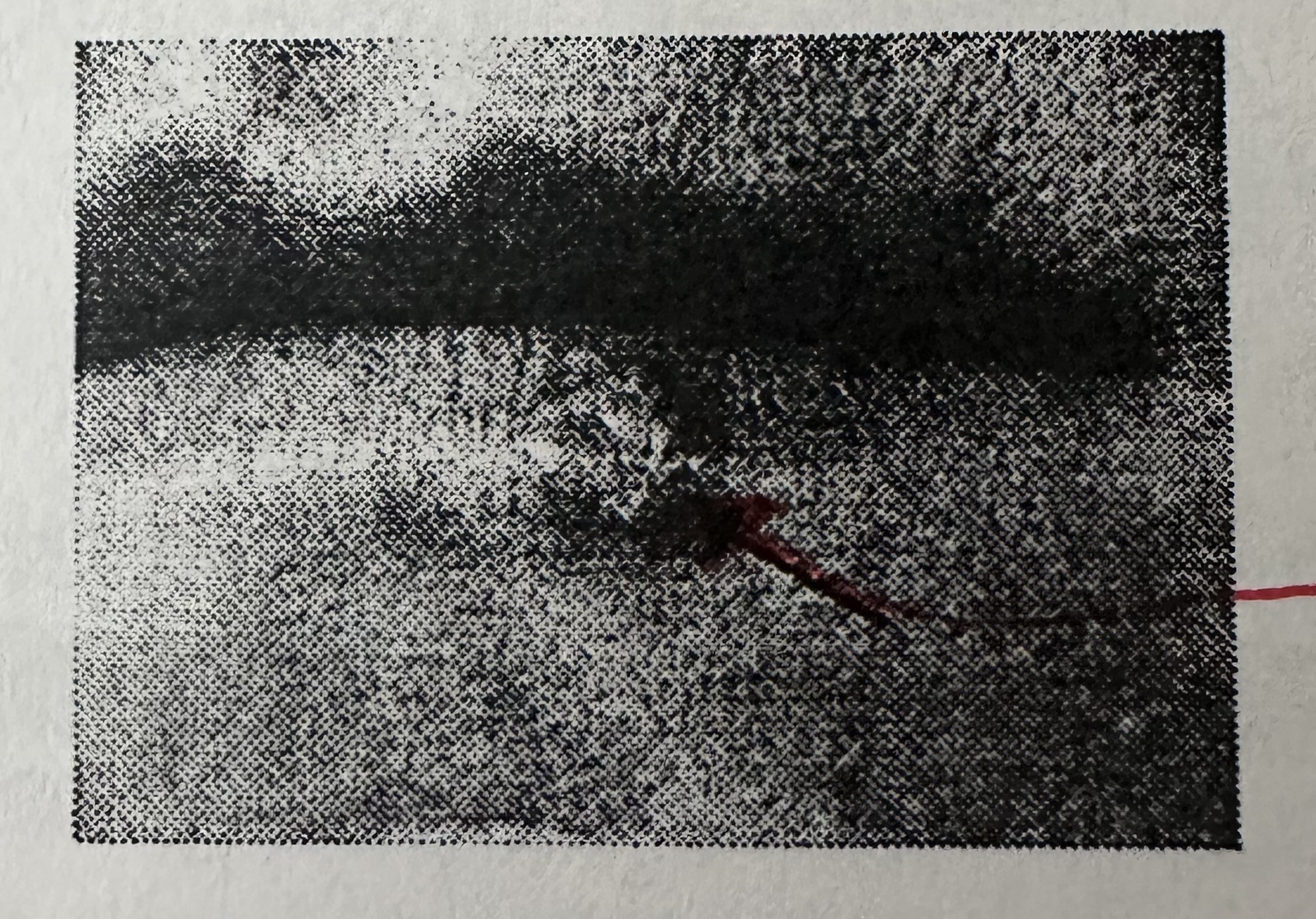
Retrovirus
A group of animal viruses that contain double-stranded RNA as their genetic information.
Equipped with reverse transcriptase enzyme transcribes RNA template “back” into DNA (reverse transcription) and DNA recombinates with host’s chromosomes (provirus).
Retroviruses reproductive cycle
Lysogenic cycle (Lysogenic infection) that at some point the cell become lytic again.

Retroviruses are called that because …
they copy their genetic information backwards from RNA → DNA. prefix retro- means “backward”.
HIV
(human immunodeficiency virus) the retrovirus that causes AIDS (acquired immunodeficiency syndrome)

Virus are responsible for …
A number of diseases in humans, plant crop, livestock, and pets.
All viruses infect …
Living cells, and disease results when infection causes harm to the host.
Infections occur when …
There is a chance contact (exposure) with a host cell.
Pathogen
Disease causing viruses (are pathogenic)
Virulence
The ability of a virus to cause disease ( they are virulent)
Factors that determine the virulence of a virus.
Presence and activity of receptors on the surface of the cell, which enables the virus to attach.
Speed at which the virus multiplies once it invades a host cell (virulent / lytic fast VS latent / lysogenic infection slow)
Response of the host organism to the invading viruses.
Could viruses been the first form of life on Earth?
Probably not, since viruses require a living host for reproduction, must have been other living things before them.
3 different ways viruses can produce infections in humans:
Lytic infection
Lysogenic infection
Tumors
Lytic infection
Virulent infection
A virus that multiplies and then undergoes lysis and destroys the host cell rapidly (virulent)
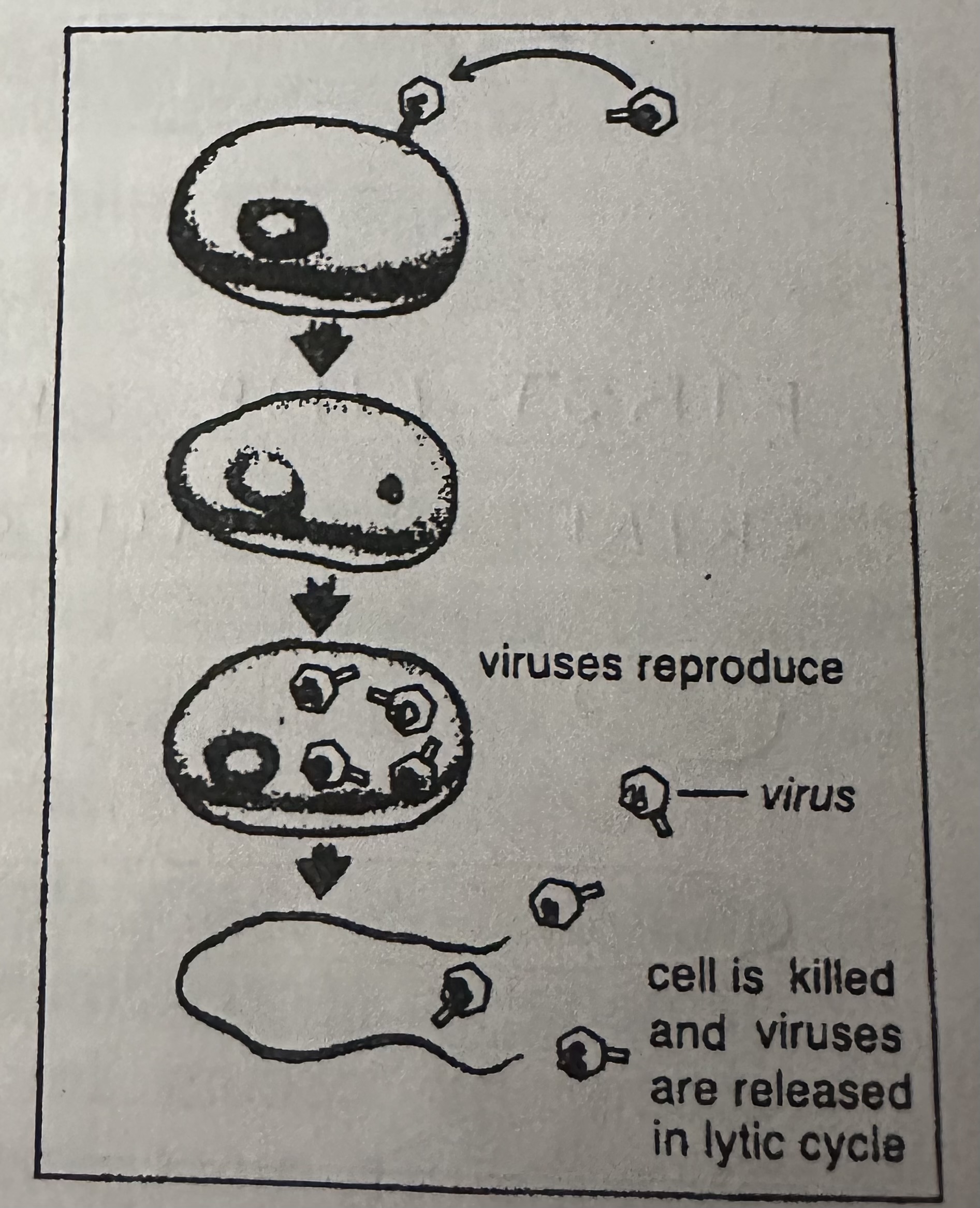
Lysogenic infection
Latent infection
A virus that exists in a cell but remains inactive (latent)
Latent virus may become activated and the virulent lytic cycle follows.
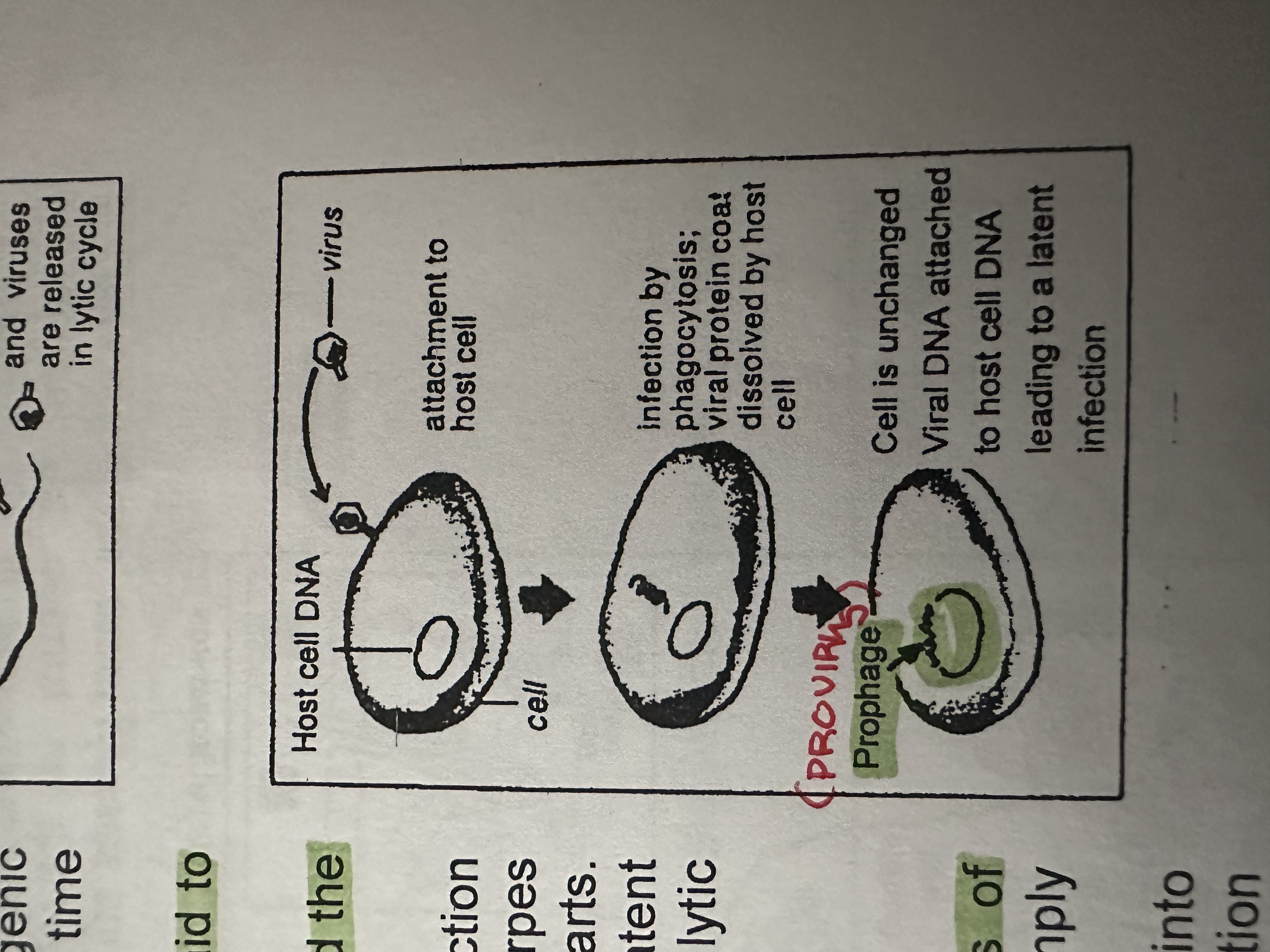
Tumors
Produce masses of abnormal cells.
Warts - benign tumors which do not have the ability to spread from their site of origin
“Cancers” - malignant tumors are capable of being spread throughout the body.
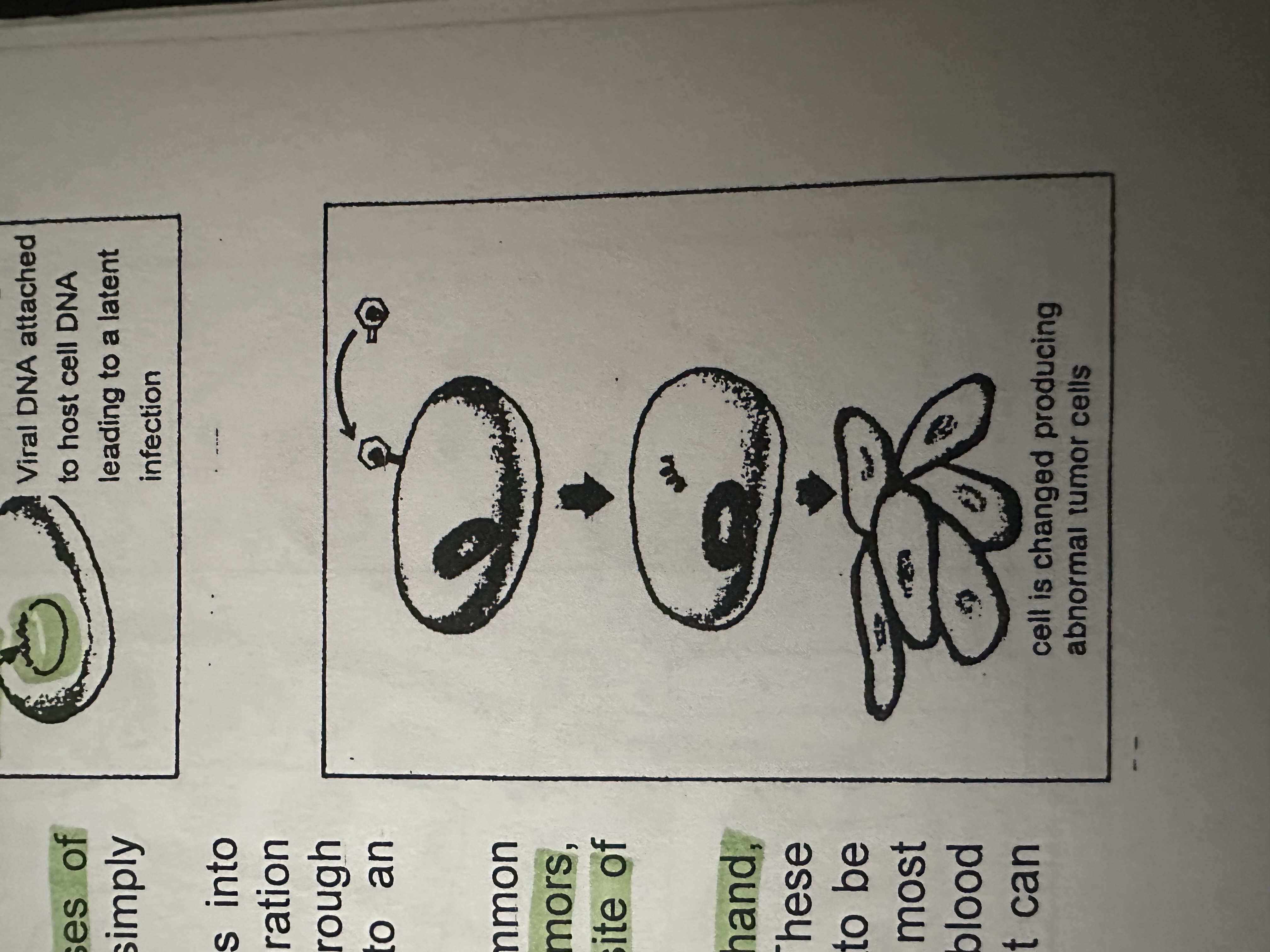
Defenses against viral infections
Human body has several natural defenses against infections. An invading virus must successfully penetrate each line of defense for an infection to occur.
Non-specific defenses
Non-specific because they operate in the same way against all disease causing microorganisms (e.g. viruses, bacteria, slivers of wood, cancer cells, etc)
First line of defence
The skin and mucous membrane, provide a barrier against pathogens.
Skin
Viruses usually cannot penetrate the skin.
Mucous membranes
Cilia and mucous inhibit the entry of some pathogens. Sticky virus stuck and swept away by ciliary action. They’re mucous, saliva, gastric juices, etc
Second line of defence
Inflammatory response begins If large numbers of viruses do enter the body (infection)
Inflammation 4 characteristic symptoms (incomplete)
Redness
Heat
Redness
When blood vessels dilate and blood rushes to site of the wound (infection), to deliver white blood cells.
Heat
Due to dilated blood vessels (blood carries heat)
By itself is protective: rising temperatures can create an environment so hot that certain microorganisms are weakened or even killed